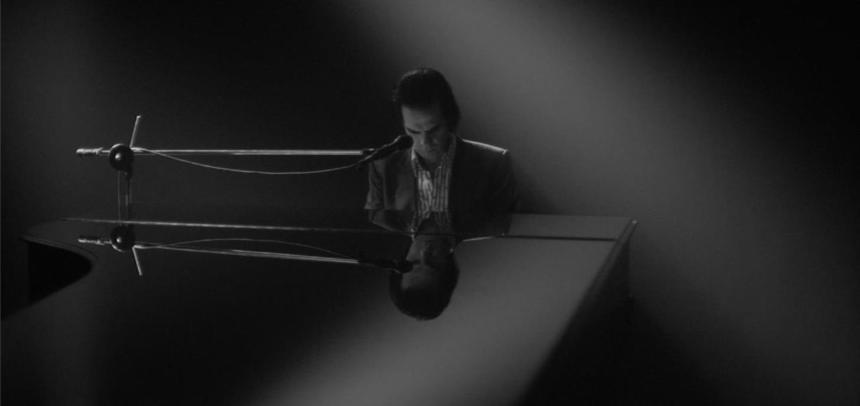Venice 2016 Review: Andrew Dominik's ONCE MORE WITH FEELING Is a Blossoming Bud of Pain

If 20,000 Days on Earth is a film you watch to get high, then Once More with Feeling is very much a downer. That’s because it deals with the deeply painful loss Nick Cave experienced after the death of his son Arthur, and how this fuelled his latest album Skeleton Tree. But even if the two sides of Nick that we see in these documentaries are as different as night and day, that’s not to say that the Cave effect is any less mesmerizing in this latest black-and-white 3D documentary marvel.
Having previously made gutsy, macho films like Chopper and The Assassination of Jesse James by the Coward Robert Ford, Dominik’s latest effort feels like a real change in flavor. The director is clearly yet another causality to the poetic charms of the eloquent Australian artist; yet the effect he has on filmmakers is definitely remarkable, and this film’s glorious music video meets documentary hybrid is no exception. Except, we should perhaps say that Once More With Feeling is “ultimately” a great film, because it gets off to an extremely shaky start.
This delayed gratification has a lot to do with the fact that this documentary seems so groundbreaking. It begins with a very “warts and all” attitude, with every second of anger or incompetence in the tense shoot seeming to be included – and as a 3D project, you can only imagine how many mishaps there were. In fact, almost the entire opening sequence is dedicated to the fact that Cave’s intimate confessions were frequently interrupted by difficulties, meaning he was quite literally having to repeat scenes once more with feeling.
At this point, an aggravated Cave even utters a line about having to wait for this “stupid black-and-white 3D camera,” something which did earn a mocking round of applause from some of the critics at the 73rd Venice Biennale. But in truth they missed the point. 3D cameras are not just a passing fad to be sneered at, when used to genuinely build upon a film’s themes (ie. not by Wim Wenders), it really is captivating. So once you get over your fear that Dominik is about to present you with 112 minutes of him struggling to master his own art, something genuinely magical happens.
At some point, a switch flicks. At some point, the film falls into the groves of its ever-present dollies and the consequences are wonderful for two reasons. The first reason is that it the 3D experience we get sometimes feels like actually being in the room with Nick Cave and the Bad Seeds. And in those moments, the screen can never feel big enough. You want the screen to expand and unfurl till the entire room is taken up by somber lights and Nick and Warren Ellis’ giant, moody faces.
The second reason is the fact that the 3D camera itself becomes a character – a figure sometimes of ridicule and inconvenience, but sometimes also of delight – and that is something I have certainly never seen in a 3D movie before (but do take note James Cameron, because it works better than Avatar ever will). What Once More With Feeling offers as a result is a movie that is both an intimate portrayal of testing time for an artist, and a film about a key form of transition within film and how it might better make people feel empathy.
At every single level the film matches the actions and qualities of the camera with the content of Nick’s thoughts and feelings. The black-and-white footage seems perfectly suited to the complexion of Nick’s mood, and it momentarily switches to colour following an important release of emotions from Nick (like the artist were using the film as a kind of recorded counselling session). Similarly when Nick talks of spiraling out of control the camera switches to swirling down a staircase, and when he talks about taking flight from pain the camera takes a visceral 3D journey out of the nearest nook and cranny in the wall.
This kind of use of the camera might seem gimmicky to some, but that is perhaps unfair to one of the first few attempts to use 3D in a way that isn’t just stuff coming out of the screen at you. And importantly, what’s actually caught with the camera is also just incredibly beautiful. Nick speaks or ruminates over the footage like an enthralling spoken-word poem, and salient scenes involve things like a grand piano, which become a striking ocean of reflection of blacks and whites under the camera’s gaze. Other great deep-focus shots often move out from the recording studio’s sound desk, before looping round the band as they perform tracks from their excellent new album.
What’s more, the inclusion of so much rough and confusing material in this doc also comes to make sense. It becomes apparent that this actually mirrors the band’s freer approach to the latest album. In Nick’s words, they did this because they wanted their new work to be an honest “document” of the immediate grief and emotions they have felt since his son’s passing – and it is certainly a melancholic triumph. For such a sad premise too, this film is remarkably an artistic pleasure to watch, and that’s a really testimony to the creative resilience of Nick Cave, his wife Susie and the rest of the band. One can only hope their grief lessens with time.






 (1)-thumb-80x80-93563.jpg)
